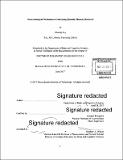| dc.contributor.advisor | Susumu Tonegawa. | en_US |
| dc.contributor.author | Roy, Dheeraj | en_US |
| dc.contributor.other | Massachusetts Institute of Technology. Department of Brain and Cognitive Sciences. | en_US |
| dc.date.accessioned | 2018-03-02T22:20:27Z | |
| dc.date.available | 2018-03-02T22:20:27Z | |
| dc.date.copyright | 2017 | en_US |
| dc.date.issued | 2017 | en_US |
| dc.identifier.uri | http://hdl.handle.net/1721.1/113955 | |
| dc.description | Thesis: Ph. D. in Neuroscience, Massachusetts Institute of Technology, Department of Brain and Cognitive Sciences, 2017. | en_US |
| dc.description | Cataloged from PDF version of thesis. | en_US |
| dc.description | Includes bibliographical references (pages 177-192). | en_US |
| dc.description.abstract | Memory is a central function of the brain and is essential to everyday life. Memory disorders range from those of memory transience, such as Alzheimer's disease, to those of memory persistence, such as post-traumatic stress disorder. To treat memory disorders, a thorough understanding of memory formation and retrieval is critical. To date, most research has focused on memory formation, with the neurobiological basis of memory retrieval largely ignored due to experimental limitations. Here, I present our recent advances in the study of memory retrieval using technologies to engineer the representation of a specific memory, memory engram cells, in the brain. First, using animal models of retrograde amnesia, we demonstrated that direct activation of amnesic engram cells in the hippocampus resulted in robust memory retrieval, indicating the persistence of the original memory. Subsequent experiments identified retained engram cell-specific connectivity in amnesic mice although these engram cells lacked augmented synaptic strength and dendritic spine density. We proposed that a specific pattern of connectivity of engram cells may be the crucial substrate for memory information storage and that augmented synaptic strength and spine density critically contribute to the memory retrieval process. Second, we examined memory engrams in transgenic mouse models of early Alzheimer's disease, which required the development of a novel two-virus approach. We demonstrated that optical induction of long-term potentiation at input synapses on engram cells restored both spine density and long-term memory in early Alzheimer mice, providing causal evidence for the crucial role of augmented spine density in memory retrieval. Third, using activity-dependent labeling, we found that dorsal subiculum had enhanced neuronal activity during memory retrieval as compared memory encoding. Taking advantage of a novel transgenic mouse line that permitted specific genetic access to dorsal subiculum neurons, we demonstrated that the hippocampal output circuits are functionally segregated for memory formation and memory retrieval processes. We suggested that the dorsal subiculum-containing output circuit is dedicated to meet the requirements associated with memory retrieval, such as rapid memory updating and retrieval-driven instinctive emotional responses. Together, these three related thesis projects have important implications for elucidating cellular and circuit mechanisms supporting episodic memory retrieval. | en_US |
| dc.description.statementofresponsibility | by Dheeraj Roy. | en_US |
| dc.format.extent | 193, 1007-1013, [101]-109, 508-512, 1536-1541, [1]-21, 1-12, 1-39, 1-6 pages | en_US |
| dc.language.iso | eng | en_US |
| dc.publisher | Massachusetts Institute of Technology | en_US |
| dc.rights | MIT theses are protected by copyright. They may be viewed, downloaded, or printed from this source but further reproduction or distribution in any format is prohibited without written permission. | en_US |
| dc.rights.uri | http://dspace.mit.edu/handle/1721.1/7582 | en_US |
| dc.subject | Brain and Cognitive Sciences. | en_US |
| dc.title | Neurobiological mechanisms underlying episodic memory retrieval | en_US |
| dc.type | Thesis | en_US |
| dc.description.degree | Ph. D. in Neuroscience | en_US |
| dc.contributor.department | Massachusetts Institute of Technology. Department of Brain and Cognitive Sciences | |
| dc.identifier.oclc | 1023435011 | en_US |
